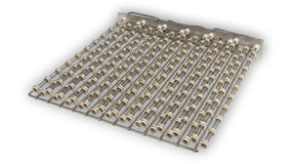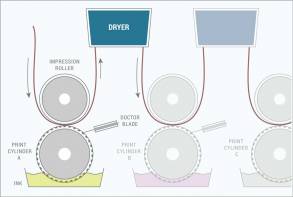Air Heaters and Dryers for Flexographic and Gravure Printing
_720_480_70_int_s_c1.jpg)
Flexographic (also called Flexo ) and Gravure printing presses use heaters for drying, curing, and thermal air handling. One popular method of drying a printed material is to use open-coil electric air heaters. Whether in-line or final stage, hot air dryers provide important benefits.

- Rapid heat-up and fast drying
- Nearly unlimited configurations
- Run multiple lines simultaneously
- Deliver enough heat to remove H2O
- Narrow or wide web applications
- Easy to maintain and replace
- Low-cost solution
- Standalone or improve drying of existing equipment
- Air heaters can be close to the drying process
- Efficient heat transfer with reduced heat-loss
The Industry Today
Printing and packaging companies want speed and quality while limiting defects, safety hazards, and maintenance. The industry is demanding faster and more efficient drying of solvents and water-based inks for both interstation and final dryer stages. OEMs seek to meet these demands with more efficient heating systems, reliable easy to maintain designs, and better control of process temperatures.
Uniform drying and the removal of saturated air is essential for quality results. That means your heating solution needs to be consistent, durable, and finely controlled. Tutco-Farnam’s Flow Torch™ is a popular heater design for drying fast moving webs. Our industrial duct heaters are also widely used in web dryers.
If you need something specific our engineering team can help you to develop a custom drying solution based on your unique needs. Use our custom heater contact form to get started.
View a custom heating element we developed to achieve higher wattage in a commercial ink drying air knife.
Flexo and Gravure Ink Drying with Heaters
Heat is needed throughout Flexographic and Gravure printing processes. Heaters are used for drying 'prints' and coatings, mold and rubber plate making, supplemental heat as well as pre-heating. The initial stage where the web is unwound may even have heated rolls to help open, flatten, and prepare the web before laying down ink. In this article, we will be focusing on two critical applications namely, interstation drying and final stage drying. In both Flexo and Gravure equipment, we are drying ink rapidly with air heaters before the surface comes into contact with equipment or itself.
Interstation drying happens between colors. The initial color is applied to material from cylinder A, that ink is dried and then the next color is applied to the same material from cylinder B. In an eight-color process you’ll have seven interstation dryers. Each station has one or more heaters broadcasting to a slotted air impinging nozzle, which in turn broadcasts the air onto the web. You could have three or four low-pressure high-volume air heaters like one of our Flow Torch™ products ducting off to multiple sections. The number of heaters may be different depending on whether you are printing magazines or dog food bags.
The final stage dryer is also called a tunnel dryer, main tunnel dryer, or overhead dryer. This last bit of drying is more thorough and completes the drying process before being stacked, folded, or rewound on to a roll. If the ink isn’t dry the material will stick to itself. The Final Stage can have many different configurations. In one example, we have a process that includes a 45” air knife with an ⅛” gap and a Flow Torch™ blasting from each side at 1,000cfm. Tutco-Farnam Industrial Duct Heaters are another popular choice.
Dial in the Speed
Speed, in this case, means a substrate material moving rapidly through a press with limited downtime during and between jobs. The temperature control system should maintain heat and airflow at high enough levels to remove moisture and solvents from the ink but not so high that the printed material becomes damaged. That sweet-spot will be somewhere between 40°C(104°F) - 180°C(356°F) depending upon many factors including substrate material, ink characteristics, machine capabilities, surrounding environment (temperature/humidity) and web speed. Paper products will be closer to 82°C (180°F) and plastic substrates will be closer to 66°C (150°F).
Press operators adjust the equipment settings to get the fastest running web they can without sacrificing print quality or damaging the web. They also seek the lowest possible web drying temperatures for that speed. Examples of excessive heat damage include ink detaching in sheets or skins, prints boiling, thermal-stress of film webs, poor registration due to stretching, stray artifacts, and other random print defects. Another issue can be print rollers taking on too much stray heat from dryers thus causing problems with ink releasing from the rollers. Flexo ink drying too quickly may result in pinholes, fisheyes, fill-in, screening, and dirty printing. Ink drying too slowly may result in adhesion and tracking problems.
Expedite Evaporation
A combination of heat and moving air is used to speed up the removal of solvent and water from ink. Flexographic and Gravure both use low viscosity inks compared to other popular printing processes. The reason for this has to do with how ink is metered and transferred. Both types of machines employ a print cylinder pressed against a substrate in order to transfer ink to the substrate. That ink is either held within an etched area on a cylinder (Gravure) or on the relief surface of a stamp attached to a cylinder (Flexographic).
In order for the ink to be transferred from an ink trough to its final destination on a substrate material, it needs to release itself from things it touches along the way. In the case of Flexographic printing, the ink will need to release from thousands of tiny cells on an anilox roller that meters the amount of ink being applied to the system. In Gravure printing, the ink must release from tiny cells in the print cylinder or on a plate or sleeve attached to the cylinder that contains the image to be printed. Ink is held in these tiny cells as a way of holding and metering the transfer of ink. On each rotation, small individual ink blobs must be released from the cells. For this process to work the ink needs to have a much lower viscosity than other processes like offset.
The ink used in Flexographic and Gravure printing (aka. liquid ink) is approximately 80% solvent and 20% solid matter. That is a lot of non-solid material that needs to leave the system quickly. The ink has either a chemical solvent or it is water-based. They are both designed to be very fast drying. High-velocity hot air is an effective means of expediting that process in a controlled and uniform manner. Air velocity, in particular, has a significant drying effect when impinged on water-based ink. Process air heaters used to remove solvent are referred to as solvent heaters.
Air Saturation
The purpose of the heated moving air in interstation drying applications is to evaporate the solvent in the ink and then move it away from the web so that the air near the surface won't become saturated. Like the Sun attempting to heat a body of water through cloud cover, solvent laden air makes it difficult for the heater to further the evaporation process. The solvent rich air needs to be moved away from the web and replaced with air that is not saturated. This can be a safety concern as well as one of process efficiency.
We'd Like to Help
At Tutco-Farnam, we design and build custom electric heating elements, hot air heaters, and complete thermal systems for OEMs in the print industry. Flexographic and Gravure presses and coaters have unique drying needs. We will help you get the right heat to the right place at the right time. Hot air can be supplied by one of our standard products configured to fit your system or we’ll work with you to design a custom heater for new or existing equipment.
Emerging ink technology, environmental regulations, and hybrid inline machines present challenging new speed, airflow, temperature, and space requirements. Tutco-Farnam has decades of experience engineering custom solutions for the most demanding applications. We can help with temperature/pressure controls, tight spaces, airflow management, energy consumption, heating efficiency, material selection, and more. We’ll work with you to tackle your toughest ink drying challenges.
Contact us today to see how we can help improve drying and curing in your high-speed printing applications.














